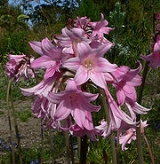
Amaryllidaceae
Overview
Amaryllidoideae is the subfamily of flowering plant
s that takes its name from the genus
Amaryllis
. It is part of the family Amaryllidaceae
, in order Asparagales
. The most recent APG
classification, APG III
, takes a broad view of the Amaryllidaceae, which then has three subfamilies, one of which is Amaryllidoideae (the old Amaryllidaceae family), and the others are Allioideae (the old Alliaceae family) and Agapanthoideae (the old Agapanthaceae family).
Flowering plant
The flowering plants , also known as Angiospermae or Magnoliophyta, are the most diverse group of land plants. Angiosperms are seed-producing plants like the gymnosperms and can be distinguished from the gymnosperms by a series of synapomorphies...
s that takes its name from the genus
Genus
In biology, a genus is a low-level taxonomic rank used in the biological classification of living and fossil organisms, which is an example of definition by genus and differentia...
Amaryllis
Amaryllis
Amaryllis is a small genus of flowering bulbs, with two species. The better known of the two, Amaryllis belladonna, is a native of South Africa, particularly the rocky southwest region near the Cape...
. It is part of the family Amaryllidaceae
Amaryllidaceae
Amaryllidoideae is the subfamily of flowering plants that takes its name from the genus Amaryllis. It is part of the family Amaryllidaceae, in order Asparagales...
, in order Asparagales
Asparagales
Asparagales is the name of an order of plants, used in modern classification systems such as the APG III system . The order takes its name from the family Asparagaceae and is placed in the monocots. The order has only recently been recognized in classification systems...
. The most recent APG
Angiosperm Phylogeny Group
The Angiosperm Phylogeny Group, or APG, refers to an informal international group of systematic botanists who came together to try to establish a consensus on the taxonomy of flowering plants that would reflect new knowledge about plant relationships discovered through phylogenetic studies., three...
classification, APG III
APG III system
The APG III system of flowering plant classification is the third version of a modern, mostly molecular-based, system of plant taxonomy...
, takes a broad view of the Amaryllidaceae, which then has three subfamilies, one of which is Amaryllidoideae (the old Amaryllidaceae family), and the others are Allioideae (the old Alliaceae family) and Agapanthoideae (the old Agapanthaceae family).
Discussions

